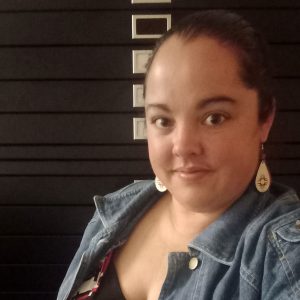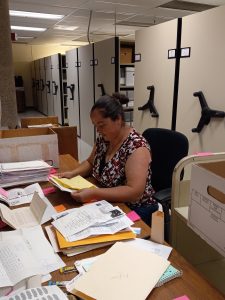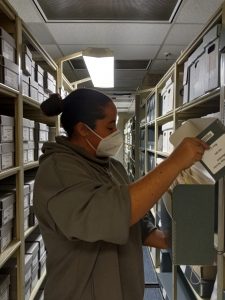As fall semester comes to an end, we will soon say goodbye to an up-and-coming archival professional and wonderful intern, Michelle Boyer-Kelly. Michelle’s internship came about when Archivist for Discovery, Sam(antha) Meier received a generous grant from the Arizona Archives Alliance to provide matching funds for a paid SCA intern. Working with the University of Arizona’s Master of Library and Information Science, Knowledge River program, Sam created a structured, for- credit, paid internship that would offer an exceptional learning opportunity, while moving forward SCA’s “Updating Legacy Description Project,” that focuses on re-description and creating better access to SCA’s collections with a focus on honoring the Protocols for Native American Archival Materials. Through a competitive application process, Michelle was selected to be our fall intern. We have asked her to provide a little background about herself and what her internship entailed:

About Me…
Greetings! My name is Michelle Nicole Boyer and I am a graduate student at the University of Arizona where I am pursuing a PhD in American Indian Studies and a Masters of Library and Information Sciences. I am also a Knowledge River Cohort 20 member. The plan (fingers crossed!) is to graduate in Spring 2023 and then find the *perfect* job as a processing archivist somewhere in the state. Ideally, I’d love to stay at Special Collections at UA, where I have been working as a student since 2009. For the past few years, I’ve been lucky enough to be a Graduate Assistant (GA) at Special Collections and the journey has been amazing. Here, I get to weave together my interests in American Indian and Indigenous Studies and archives.
My Past Experience…
As a GA, I have been able to get hands-on experience processing archival collections. One of my larger projects was the processing of the Jack

Sheaffer photograph collection. Jack was a photographer for the Arizona Daily Star – Sheaffer took over for Sam Levitz when he decided to sell furniture – and his collection consists of hundreds of thousands of photographic negatives (mostly 4×5 and 35mm) and a peppering of printed versions of those photographs in newspaper clippings. It was a huge endeavor that I spent approximately five years on. Also of note, this finding aid (that I encoded by hand – before ArchivesSpace!) broke Arizona Archives Online (AAO) when it first launched. It will always be *the* collection I discuss as being my favorite because of how close I became to this collection.
I have also processed other paper-based collections, have done work with digital collections, create the occasional pop-up student exhibit, am part of a student blog, have attended conferences to discuss my work as a GA, and in the process have become very familiar with the creation of finding aids. I’m currently working on processing poet Joy Harjo’s collection (my supervisor knows how much I love Harjo’s poetry, care about Indigenous collections, and made note when I mentioned I would love to process these papers!), which I think will likely be another one of my most notable projects. Learning how to write, organize, and eventually get a finding aid somewhere that it can be viewed by patrons is a lengthy (but rewarding) process. Actually, creating finding aids and working with legacy finding aids is one of my favorite things to do within the archives!
The Internship!
I think it is important to note that all MLIS students at the University of Arizona are required to complete an internship that is wholly separate from any tasks they have at UA. Internships are designed to give students, like myself, “hands on” experiences that prepare them for future work in the field. In a perfect world, every intern is going to find an internship that (1) is in the field they wish to enter, (2) revolves around a subject/topic/task they are passionate about, and (3) is paid. I will be very honest when I say many of my friends and peers have not been able lucky enough to check all three of these boxes. I, however, was extremely lucky!
NAU’s Updating Legacy Description Internship was the perfect fit for me as an intern and I was thrilled to be offered this opportunity! But what did I do for this internship? To begin, let’s discuss “legacy description” and “legacy finding aids” – any finding aid that existed when finding aids were only paper and were not accessible online is probably what one would call a “legacy” finding aid. They’re older documents that were created long enough ago that they are going to need updates as things in the archival profession change. One of the main things that needs constant updating in “description” and “metadata.” Older finding aids sometimes use language that is no longer in use, refer to places or people in ways that are no longer effective, and sometimes just need to be updated to better discuss the collection, its creator, etc. For example, many finding aids across the country one used Papago to refer to the Tohono O’odham – as times have changed, the Tohono O’odham have expressed a desire to only be referred to by their preferred name; changing a finding aid to reflect this is an example of updating a legacy finding aid. Adding more information about a donor (now that you have found more information, or more information has become available) is another example of making updates as needed.
While interning at Cline Library Special Collections and Archives’ (SCA) my supervisor, Sam Meier, asked me to look through SCA’s collections and identify a collection(s) I was interested in working on throughout the internship. First and foremost, I love that Sam was willing to let me, as an intern, determine what spoke to me and intrigued me. I ended up selecting an oral history collection that includes 25 interviews with indigenous individuals who were actively working within Indian Education. This collection was interesting because (1) it included ¼” reel audio and access cassettes, (2) some transcripts, and (3) predominantly revolved around American Indian voices and experiences – the kind that I think we need to hear more of in the archives!
The hands-on work of this internship revolved around updating the finding aid for this collection. This included strengthening the biographical note about the collection’s creator, Dr. Rulon. Gathering information from various sources, I was able to add a few more

paragraphs about Rulon, his work, and this project. I was also able to gather more information about the collection that would be pertinent to researchers. For example, it is important to note that this collection has reels and audiocassettes, but the new finding aid will also have links to digital recordings of these interviews (super helpful because the reels are essentially obsolete and cassettes, in general, are hard to access even if you have a device in-house that can play them). But, I also updated outdated terminology throughout the finding aid that better reflects contemporary naming conventions for specific American Indian nations.
Once I created an initial EAD (via XML), I was able to upload it to ArchivesSpace and continue making edits/corrections on the document. Towards the end of the internship, my task was to then export an EAD file that can, eventually, be updated on AAO. This EAD will also be available for future work – because, as we know, things can change over time and edits will still be needed in the future.
Aside from this hands-on work, Sam created several Zoom meetings with other experts in the field where I was able to learn more about the ins-and-outs of what we use daily. For example, I attended meetings with some of the founders of AAO and was able to pick their brains about interesting aspects of this state-wide resource. We met with individuals working at ASU, where I was able to ask questions about repatriation (although, please note this is not always the ‘correct’ word to use when we are discussing returning materials to tribes à which was highlighted at this meeting!) and future plans for continued description work. Simply put, I was able to network as well as learn about different projects being handled at different institutions across Arizona.
This internship was also done remotely. I cannot stress enough how perfect this internship was for me, a student living down in Tucson. This is the exact kind of work that I want to do in the future! But, I could never have completed this internship had SCA not been innovative and willing to complete remote internships. My internship with SCA was amazing. While I have worked with XML, EAD, and ArchivesSpace before – with SCA I was able to explore new components and features of ArchivesSpace that I have never had to use as UA. For example: the import feature! My daily routine has never involved importing, but this internship allowed me to practice using the import feature. These little things will strengthen my future knowledge of ArchivesSpace and the field, in general.
I cannot thank SCA enough for this opportunity, and have to especially that Sam for being willing to meet with me weekly via Zoom, include me in several meetings, and work through all of my questions with me. I truly hope that this type of work can continue throughout the archival field – and especially hope that a future intern with SCA falls in love with this internship as much as I did!
We have enjoyed our time with Michelle and wish her all the best in her archival career. We’re certain that Michelle is going to contribute to the profession in many positive ways, and this is just one of the many ways that Special Collections and Archives is “Elevating Excellence.”